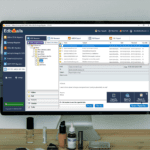
An enterprise application requires a near-perfect UX design. The closer we are to perfection the more elusive it seems. It is a sort of myth in the enterprise environment. User Experience design is a continuous process. There is always something to improve upon, something to add, and even, something to subtract.
There are many challenges that a designer might face when trying to make the perfect UX experience. There is a difference between enterprise and end-user software design. Enterprise software has more restrictions and demands compared to end-user software design. Some of these challenges might seem strange and unheard of. The sometimes intricate corporate maze of bureaucracy is unique to every company. This is just one of the unique layers of enterprise design that we need to take into account.
How do we tackle these problems? The very first step is to understand them.
Bullet point checklist of problems
As mentioned before, enterprise software design comes with its own set of problems that we must face and overcome. At first, these obstacles may appear to be time, effort, and money-consuming. It is our job to deal with these problems as efficiently as possible.
In this article, we will go over a list of potential problems that many may face when designing enterprise software. If we can present them, we can understand them. And if we can understand these problems, we can measure them and ultimately, solve them.
Old, Legacy systems
Enterprise tends to get stuck in old systems. Infrequent investments into UX design tend to make their systems obsolete. Many a time, this means a complete system overhaul, from the ground up. But it does not have to be that way. Generally speaking, it is always better to start from scratch when designing software. It is a better alternative to trying to fix and build upon old, obsolete code. But the truth is, that most designers are forced by time and/or financial constraints to work upon those legacy systems. These old systems are a barrier to designing a proper User Experience. Such code was written long before aesthetics and user experience metrics were a thing.
So, we have to find a way to work around it. Another obstacle is the resistance towards change. Employees tend to be set in their ways. Solve the longstanding issues, and the employees will accept the change.
Understanding the end-user (the employee)
We need to gain access to the end-user. This is the best way to understand what needs to be fixed and improved upon. When designing enterprise software, consider partnering up with the client. Use this partnership to research their business operation. In turn, you will gain an understanding of the user requirements. Finally, you will be able to fulfill those. Enterprise software is a little different. It is not meant to generate revenue. It is meant to increase employee productivity, which in turn makes them more efficient in generating revenue.
The company’s idea on how to increase said productivity can often clash with your ideas of UX design. Bureaucracy is also another big consideration that we have touched upon earlier. The trick is to start small. Conduct meetings in small groups. Pick various teams and extract tiny bits of info. In the end, will combine it into a finished product.
Fulfilling the users’ needs
When designing any application, it is easy to focus solely on aesthetics. But this is not all UX is about. Primarily, we need to focus on a user-friendly user experience. Looks are important, especially for brands that pay the top amount. But it is not the core focus of UX design. What we want is for users to explore and enjoy the application while doing so. Functionality is the main goal.
The application is there to help employees generate revenue, not to generate it. This will mean giving users what they need, not what they necessarily want. Early design stages benefit greatly from user feedback. Ask around what they would like to see and be able to do. No one will provide more clear pointers. Do note, you will need a big enough sample size. This means, making sure you ask enough people and act accordingly.
Take risks
A good UX design requires experimentation. We can see how this can be problematic. In a business setting, any sub-optimal feature or performance metric can mean a loss in revenue. Large companies hate taking risks they have no control over. They want to know or at least take an educated guess on what the outcome will be. Their profit margins and the employee’s livelihoods depend on it. Most of the aversion towards experimentation will come from middle management. This is because they have to deal with both employee and high management demands. How do we make them trust us with small-scale experiments?
Design workshops will help executives understand your input into designing the perfect UX. Establish a clear line of communication to optimize your chances of them accepting a small amount of risk-taking. Properly convey the large benefits of taking this small risk.
Limiting the choice pool for the users
Good UX design needs to equip its users with enough tools in order for them to accomplish their individual goals. But there is a limit to this. An overabundance of choice can lead to decreased efficiency from the perspective of the employee. With an overwhelming choice pool, employees can become paralyzed in their daily business activities. The expression “spoiled for choice” comes to mind. An excess of features will also increase the development and design time and budget.
Product maintenance in the future will also become a nightmare. There is a fix to this. Every newly added feature needs to be authorized by the required personnel. Also, make your own studies that conclude if the added feature is bringing value to the entire experience. Identify the unnecessary features and remove them, but without it affecting the performance of the entire experience.
Deadlines
Deadlines are always short, we think everyone can agree on that. With that in mind, the initial phase of the project is to deliver the best output possible. We can see how these two can be at odds with each other. A good design requires time, the kind of time we usually do not have. Therefore, projects like these tend to be rushed. This is where we start missing business requirements and start making mistakes. It is a spiral effect where the management and the technical teams tend to lose trust in one another.
Here is how to deal with this. Firstly, identify the key features the product needs to have. Proper planning is crucial. Plan for incremental changes. A minimum amount of change can improve UX design. GWM experts implement their own methods to navigate through a development process. Only with a firm plan can you fulfill the customer’s needs.
Securing the resources
UX research demands outgrow the capacity of pretty much every organization. This is why most companies but the biggest of giants contract other companies to do this. Even if you have your own dedicated UX research team, they most likely do not have enough capacity to answer every single question to everyone. They would need to cover designer, product manager, and marketing questions, just to name a few. And the demand is always increasing. Everyone wants to do more research.
UX design budgets do not match this increase in demand. A solution appears in cloud-based user research platforms. These can run unmoderated research every week. This means a higher pace for less money, compared to just a few years ago. Another useful thing to do is to spread insight, education, and training on UX research throughout the organization. This means making the employees a part of the process.
The mobile world
Currently, there are thousands of different devices that we need to adapt our UX to. These devices have their own specification and characteristics. From screen resolutions to different operating systems, we need to account for all of these differences and design appropriately. Yes, it would be easier if all of these variables were actually fixed in place. Then we could design for a singular environment and our lives would be much easier. But the truth is, this market is constantly shifting and we need to adapt to it.
The solution is to employ the adaptive design method. This is pretty much a standard UI and UX design method that adapts the elements on a page of an application to the customers’ screen. This translates to a pleasurable viewing experience where all the necessary data is presented. No scroll bars or chopped-off pieces of content.
These are just some of the challenges we might face when designing a good application UX. Enterprise software will always have its unique requirements and no two are going to be the same. All parties involved can reach an understanding of the demand in order to design a better experience for everyone.








